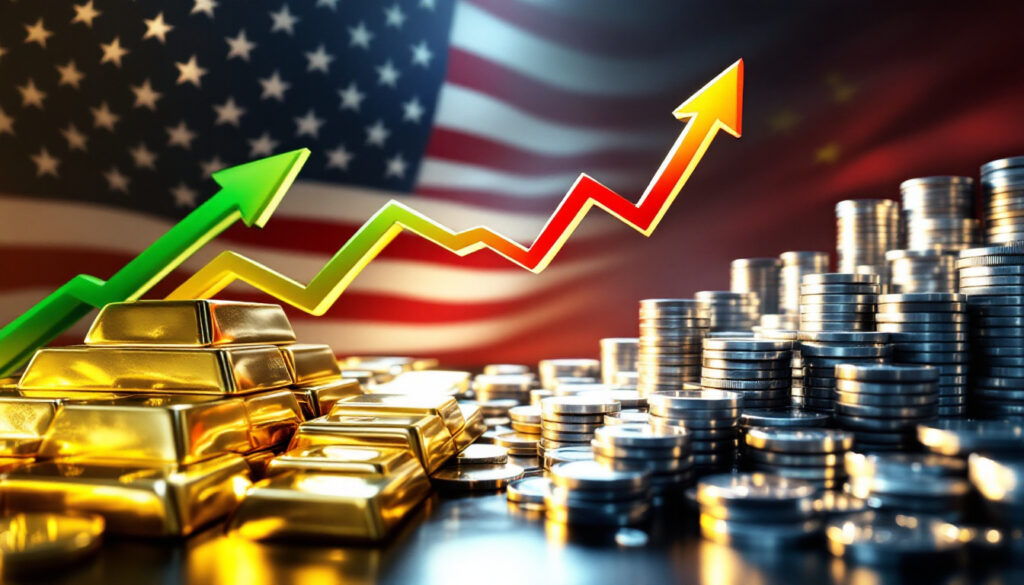Gold and Silver Prices: Why Recent Declines Signal Economic Strength
Gold and silver prices have recently experienced a notable pullback from record highs, signaling important shifts in the broader economic landscape. Gold dropped by 0.63% ($21) to $3,323.80, while silver fell by 0.59% (approximately $0.19) to hover around the $33 mark. This decline represents a modest correction after gold's impressive climb to nearly $3,500 per ounce just last week.
These movements, while seemingly concerning to precious metals investors at first glance, actually reveal underlying strength in the global economy and offer important insights into market dynamics that go beyond simple price fluctuations. Understanding the comprehensive gold market analysis is essential for investors navigating these markets during periods of volatility.
Why Are Gold and Silver Prices Falling?
The recent decline in precious metals prices stems primarily from positive economic developments, particularly the easing of trade tensions between the United States and China. This represents a classic market response to improving economic conditions rather than concerning market manipulation.
When major economies signal cooperation rather than conflict, investors typically shift capital from safe-haven assets like gold and silver toward growth-oriented investments such as equities. This reallocation reflects growing economic confidence rather than fundamental weakness in precious metals markets.
Economic Factors Behind the Price Movement
Several specific economic indicators have contributed to the current price adjustment:
- Improved trade dialogue between the world's two largest economies
- Stronger-than-expected manufacturing data
- Reduced geopolitical risk premiums in various asset classes
- Shifting investor sentiment toward risk assets
These factors have collectively created short-term headwinds for precious metals while simultaneously strengthening equity markets and certain currencies. A thorough price drivers analysis helps investors contextualize these movements within broader market trends.
How Trade Relations Impact Precious Metals
Trade tensions historically drive investors toward safe-haven assets like gold and silver. During periods of economic uncertainty, precious metals typically outperform other asset classes as investors seek protection from market volatility.
The current easing of tensions has naturally reduced some of this "fear premium" in precious metals prices, causing the modest decline we're witnessing. It's worth noting that despite this adjustment, prices remain near historic highs, suggesting underlying support for gold and silver remains robust.
"Trade tension reduction typically decreases immediate safe-haven demand, but doesn't eliminate the long-term case for precious metals in a well-diversified portfolio. These short-term movements often create strategic entry points for long-term investors." — Market analyst perspective
How Are Markets Responding to Improved Trade Relations?
The broader market response to improving trade relations provides important context for understanding precious metals movements, as various asset classes show distinct correlation patterns.
Stock Market Performance
While precious metals experienced modest declines, equity markets have responded positively:
- Dow Jones Industrial Average: Up 300 points (approximately 0.33%)
- NASDAQ: Up 95 points
- S&P 500: Up 32 points
This equity strength reflects capital rotation from defensive positions into growth-oriented investments – a classic pattern when economic outlooks improve. These movements are part of broader global commodities insights that investors should monitor.
Currency and Commodity Markets
The ripple effects of improving trade relations extend beyond stocks and precious metals:
- US Dollar Index: Up 0.14% to 99.18 (still below the psychologically important 100 level)
- Crude Oil: Down $1 to $60 per barrel
- Base metals: Generally down across the board
These movements create a complex market landscape where various assets respond differently to the same fundamental factors, highlighting the importance of understanding interconnected market relationships.
Trade Policy Developments
Specific policy announcements have triggered the current market adjustments:
- Plans to reduce auto tariff impacts by lowering taxes on foreign parts used in US-made vehicles
- Measures ensuring imported cars aren't subject to multiple tariffs
- China's exemption of certain US goods from retaliatory tariffs
These concrete steps toward trade normalization provide substance behind the market movements we're witnessing.
What Makes This Gold Price Decline Different?
Not all precious metals price declines are created equal. This particular movement differs significantly from corrections driven by market manipulation or speculative activity.
Positive Economic Underpinnings
Unlike price drops caused by market manipulation concerns, this decline represents a natural market response to improving economic conditions. Treasury Secretary Scott Bessant noted that several top trading partners have made "very good proposals" to avoid US tariffs, reinforcing that positive economic fundamentals are driving current price movements.
This distinction is crucial for investors to understand, as economically-driven price adjustments often prove more predictable and manageable than those stemming from market manipulation or liquidity events.
Limited Magnitude of the Decline
Despite significant positive economic news, gold's price drop was remarkably modest at only 0.63%. This limited decline suggests substantial underlying strength in precious metals markets and continued investor caution about broader economic conditions.
For perspective, gold has previously experienced single-day declines exceeding 2-3% during similar economic pivots, making the current adjustment notably restrained by historical standards. Analyzing long-term gold price trends helps investors place these movements in proper context.
Silver's Relative Resilience
Silver's performance during this decline demonstrates particular resilience, falling slightly less than gold at 0.59%. This outperformance highlights silver's dual nature as both a precious metal and industrial commodity.
As economic prospects improve, increased industrial demand for silver in manufacturing, electronics, and renewable energy applications can partially offset reduced investment demand, providing additional price support.
What Economic Indicators Should Precious Metals Investors Watch?
Strategic precious metals investors should monitor several key economic indicators to anticipate future price movements and potential entry or exit points.
Upcoming Economic Data
Several critical economic reports in the coming days will likely influence precious metals markets:
- Personal Consumption Expenditures (PCE) price index: The Federal Reserve's preferred inflation gauge
- Monthly non-farm payrolls report (Friday): Key indicator of employment trends
- Federal Reserve policy signals: Communications regarding interest rate trajectories
These data points will provide essential insights into inflation trends, economic strength, and monetary policy direction – all crucial factors for precious metals pricing.
Signs of Economic Slowdown
Despite positive trade developments, several concerning economic signals remain:
- UPS announcement of worker layoffs: Potential indicator of slowing logistics demand
- Manufacturing sector contraction: Ongoing in several key industries
- Rising corporate debt levels: Potential stress indicator for economic stability
These factors could provide counter-cyclical support for precious metals if they worsen, as investors might seek safe-haven assets despite improving trade relations.
What Are the Price Projections for Gold and Silver?
While short-term market movements remain unpredictable, technical analysis and fundamental factors suggest several important price targets for precious metals.
Gold Price Forecasts
Market analysts have identified several key price thresholds for gold:
- Near-term resistance level: $3,500 (where liquidation pressure may increase)
- Quarter-end projection: $3,590
- Year-end forecast: $3,800 per ounce
These projections suggest that despite the current pullback, the overall trend remains bullish for gold, with potential for new record highs before year-end. The gold market outlook 2025 provides further long-term perspective for investors.
Silver Price Support Levels
For silver, the $33 level represents a critical psychological and technical threshold:
- Currently trading above $33 in the ask price
- Slightly below $33 in the bid price
- Historical resistance level now serving as support
Maintaining this level would demonstrate continued market strength and potentially set the stage for silver to approach the $40 mark as we move into the final quarter of the year. As noted in the latest gold-silver ratio analysis, the relationship between these two metals continues to provide important market signals.
How Should Investors Approach Precious Metals in This Environment?
Current market conditions require strategic thinking from precious metals investors, balancing short-term price movements against long-term wealth preservation goals.
Long-Term Investment Perspective
Precious metals investment demands a strategic approach focused on:
- Ounce accumulation: Prioritizing physical quantity over dollar valuation
- Intergenerational wealth transfer: Considering assets that transcend currency systems
- Volatility acceptance: Recognizing that short-term price fluctuations are normal in a long-term asset class
This perspective allows investors to view current price adjustments as part of a normal market cycle rather than concerning disruptions.
Buying Opportunity Considerations
For those building positions, price dips often present strategic entry points:
- Current prices remain near historic highs but below recent peaks
- Dollar-cost averaging can help manage volatility and entry timing
- Physical metal premiums may decrease during price pullbacks, offering additional value
These considerations help transform market corrections from concerning events into potential opportunities for strategic investors. Many analysts, including those at Guardian Gold, suggest that current levels represent potential entry points for long-term investors.
Liquidation Timing Concerns
For investors nearing retirement or considering selling:
- Price at time of liquidation becomes critically important
- The current environment may not be ideal for major position reductions
- Strategic partial liquidations during price peaks can help manage risk
- Tax considerations should be evaluated before any significant sales
These factors highlight the importance of having a predetermined exit strategy rather than making reactive decisions based on short-term price movements.
What Broader Economic Factors Continue to Support Precious Metals?
Despite the current price pullback, several fundamental factors continue to provide long-term support for gold and silver prices.
Currency System Concerns
Multiple structural issues continue to underpin precious metals demand:
- Ongoing discussions about potential currency system resets: Including central bank interest in gold reserves
- Concerns about central bank digital currencies (CBDCs): And their implications for privacy and financial freedom
- Long-term inflation expectations: Despite recent moderation in inflation data
- Record government debt levels: Creating potential currency debasement concerns
These factors continue to make precious metals attractive as insurance against monetary system uncertainties.
Market Volatility Hedging
Gold and silver continue to serve as portfolio insurance against:
- Unexpected economic disruptions: Including banking system stresses
- Geopolitical tensions: Which remain elevated despite trade improvements
- Market volatility: Particularly as equity valuations remain historically elevated
- Currency fluctuations: Including potential dollar weakening scenarios
This protective function remains valuable even during periods of economic optimism, as systemic risks persist despite improving trade relations.
FAQs About Recent Gold and Silver Price Movements
Is this price decline a sign that gold's bull market is ending?
No, this appears to be a normal correction within an ongoing uptrend. Gold recently reached an all-time high near $3,500, and the current pullback to $3,323 represents a modest 5% correction. Analysts continue to project higher prices by year-end, with technical indicators suggesting the primary trend remains bullish.
Historical bull markets in gold have typically included multiple 5-10% corrections even while maintaining their overall upward trajectory. The limited magnitude of the current pullback, despite significant positive economic news, suggests underlying strength rather than trend reversal.
How does silver typically perform compared to gold during economic improvements?
Silver often demonstrates more volatility than gold due to its dual role as both a precious metal and industrial commodity. During periods of economic improvement, silver can sometimes outperform gold as industrial demand increases, offsetting reduced safe-haven buying.
This hybrid nature makes silver particularly interesting in the current environment, as improving economic conditions could boost its industrial applications in electronics, solar panels, and manufacturing while its precious metal characteristics provide continued investment appeal.
Should investors be concerned about further price declines?
While short-term volatility is always possible, the relatively modest nature of the current decline despite significant positive economic news suggests underlying strength in precious metals markets. Investors should focus on their long-term allocation strategy rather than short-term price movements.
Technical support levels remain intact, and fundamental factors supporting precious metals have not fundamentally changed despite improving trade relations. Maintaining proper portfolio allocation percentages and viewing price dips as potential rebalancing opportunities represents a prudent approach.
How might Federal Reserve policy impact gold and silver prices?
Upcoming economic data will influence Federal Reserve policy decisions. If data suggests persistent inflation or economic weakness, the Fed may maintain higher rates for longer, potentially creating headwinds for precious metals. Conversely, signs of economic slowing could accelerate rate cut expectations, supporting gold and silver prices.
The relationship between interest rates and precious metals prices is complex, with real rates (nominal rates minus inflation) typically showing stronger correlation than nominal rates alone. This makes both inflation data and Fed communications critically important for precious metals investors to monitor.
What role do physical precious metals play in a diversified portfolio?
Physical gold and silver provide portfolio diversification benefits that differ from paper assets like stocks and bonds. They serve as wealth insurance, inflation hedges, and assets that can be passed between generations. Their value transcends current market conditions and should be viewed within a long-term wealth preservation strategy.
Unlike many financial assets, physical precious metals carry no counterparty risk and have maintained purchasing power over centuries despite currency devaluations and economic disruptions. This unique characteristic makes them valuable portfolio components regardless of current price movements or economic conditions.
Keen to Identify Early-Stage Mining Opportunities?
Discover significant ASX mineral announcements before the broader market with Discovery Alert's proprietary Discovery IQ model, providing real-time alerts and actionable investment opportunities. Explore historic returns from major discoveries on our dedicated discoveries page and position yourself to capitalise on the next market-moving discovery.




